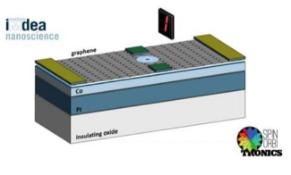
A major challenge for future spintronics is to develop suitable spin transport channels with superior properties such as long spin lifetime and propagation length. Graphene can meet these requirements, even at room temperature [1], but other active properties, such as magnetic order and large spin-orbit coupling (SOC), need to be incorporated into graphene. The ability of controlling the magneto-resistance states of magnetic elements by external fields via spin- and orbit- degrees of freedom is at the basis for the development of next generation spintronics [2].
Here, I report on interface engineered epitaxial graphene based magnetic heterostructures in which the surface and magnetic properties are controlled via proximity with intercalated layers [3,4]. Graphene/ferromagnetic based systems deposited on heavy-metal (HM) buffers grown on (111)-oriented insulating oxide crystals, exhibits enhanced perpendicular magnetic anisotropy (PMA), extended up to 4 nm thick in case of Co, and chiral (left-handed Néel-type) domain walls stabilized by interfacial antisymmetric exchange Dzyaloshinskii-Moriya interaction (DMI) localized at both graphene and HM interfaces with opposite sign [5,6]. Such chiral spin textures are promising candidates for high density, low energy consumption and fast spintronics devices, or novel reservoir and neuromorphic computing, while the presence of graphene enables the possibility to (electrically) tune the spin-orbit driven properties [7].
[1] W. Han, et al. Graphene Spintronics, Nat. Nanotech. 9, 794 (2014).
[2] B. Dieny et al. Opportunities and challenges for spintronicsin the microelectronics industry. Nat. Electr. 3, 446–459 (2020).
[3] F. Ajejas, et al., Thermally Activated Processesfor Ferromagnet Intercalation in Graphene-Heavy Metal Interfaces. ACS Appl. Mater. Interfaces, 12(3), 4088-4096 (2020).
[4] M. Blanco-Rey, et al. Large Perpendicular Magnetic Anisotropy in Nanometer-Thick Epitaxial Graphene/Co/Heavy Metal Heterostructures for Spin-Orbitronics Devices. ACS Appl. Nano Mater. 4(5), 4398–4408 (2021).
[5] F. Ajejas, et al., Unravelling Dzyaloshinskii-Moriya interaction and chiral nature of Graphene/Cobalt interface. Nano Lett. 18(9), 5364-5372 (2018).
[6] P. Olleros-Rodríguez, et al. Intrinsic mixed Bloch-Néel character and chirality of skyrmions in asymmetric epitaxial trilayer. ACS Appl. Mater. Interfaces 12(22), 25419–25427 (2020).
[7] A. Anadón, et al. Engineering the spin conversion in graphene monolayer epitaxialstructures. APL Materials 9, 061113 (2021).
Universidad Autónoma de Madrid © 2008 · Ciudad Universitaria de Cantoblanco · 28049 Madrid · Información y Conserjería: 91 497 43 31 E-mail: informacion.ciencias@uam.es Gestión de estudiantes de Grado y Posgrado: 91 497 8264 / 4329 / 4353 / 4349 / 6879 / 8362 E-mail: administracion.ciencias@uam.es